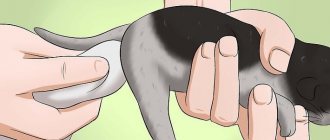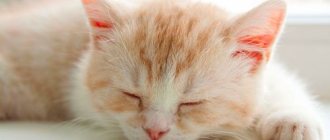No pet can tell its owner how it is feeling. Therefore, any changes in your pet’s behavior should alert you.
One of the main and noticeable symptoms is hematuria. This problem can easily be seen in domestic cats and cats that go to the litter box. If detected, you should immediately contact a veterinarian.
What you can encounter and what the owner should be afraid of
To begin with, urine is the fluid that is excreted from the body as a result of the work of the kidneys, ureter and bladder. Along with it, various toxins, micro- and macroelements go away. Normally, it should be transparent or light yellow.
Diuresis in a healthy pet is 1-2 ml/kg/h. A minimum of 1 ml should be released.
For example, a pet weighs 4 kg, let’s calculate (1 ml x 4 kg x 24 hours = 96 ml), therefore, it should release approximately 96 ml per day.
What to do if blood appears in the urine: treatment at home
In severe situations, when bleeding threatens life, or calculi (stones) clog the lumen of the excretory canals and block the outflow of urine, surgery is performed in the clinic. In most cases, the animal owner takes part in treating the pet at home, following the orders of the veterinarian.
The therapeutic strategy is based on diet therapy and drug treatment.
Diet therapy
If a cat pees in blood, then proper nutrition cannot be avoided for the following reasons:
- It is necessary to maintain average fatness. Cats that do not walk outside, especially sterilized ones, are prone to overeating with reduced physical activity. Boredom causes them to develop an appetite. In obese pets, metabolism slows down, fat puts pressure on the urinary organs, urine stagnates, which contributes to the attachment of microbes to the wall of the bladder, as well as the precipitation of urinary salts.
- Economy class feeds and natural products are unbalanced in protein. They have a low concentration of energy, little dietary fiber and vitamins. A significant part of the defective protein is not digested and is converted into uric acid. Nitrogenous slag is poorly soluble in water, is prone to precipitation and is a breeding ground for microbes.
- In animals predisposed to urolithiasis, 2 types of stones form. Phosphorus-rich struvite forms in alkaline urine. In acidic urine, oxalates—calcium salts and oxalic acid—precipitate. The veterinarian conducts a urine test, makes a diagnosis, based on which he recommends the use of specialized medicinal food.
Depending on the presence of stones and the patient’s condition, the following veterinary feeds are used:
- Purina UR for urolithiasis;
- Hill's Metabolic + Urinary for weight loss and struvite dissolution;
- Eukanuba Urinari Oxalate;
- Eukanuba Urinari Struvite;
- Royal Canin Neutered Adult Maintenance for the prevention of urolithiasis and obesity in sterilized cats.
Be sure to read:
Diarrhea in a kitten: what to do, first aid, causes, treatment, medications and folk remedies
Medicines and folk remedies
Veterinarians prescribe complex remedies. The drug Stop-cystitis in tablets or suspension contains the antibiotic nitroxoline and the antispasmodic drotaverine, which inhibit pathogenic microflora, relieve spasms and relieve pain.
Most of the drugs popular in the treatment of diseases of the urinary canal, kidneys and bladder are produced on the basis of traditional medicine and are a mixture of extracts of medicinal herbs.
The following herbal remedies are popular:
- Stop Cystitis Bio;
- Erwin the cat;
- Phytodoc Nefrospas;
- Urolex;
- Urinari tract support.
Causes of hematuria
There are many different causes of blood in urine that you need to know about:
- Inflammatory bladder disorders caused by bacterial infection.
- Changes in the urethra or vestibule of the vagina. Blood does not appear with every urination, but only in episodes. About 10% of all cats are susceptible to the disease.
- Injury to the animal. This could be a fall from a height, a strong blow, or a “meeting” with the wheels of a car.
- Kidney diseases, namely urolithiasis. Stones in the organ or bladder often appear in cats over 7 years of age.
- An increase in uric acid salts in the animal’s urethra.
- Hemophilia or blood clotting disorders. The walls of blood vessels deteriorate, causing blood to leak into the urine.
- Some urinary tract infections. Pathogens can get there due to kidney stones or deterioration of immunity during primary diseases. When stones occur, the mucous membrane of the bladder is torn, so there is a high chance of contracting an infection.
- Tumors of the kidneys, ureter or bladder.
- Anatomical pathologies. Disturbances during the laying of embryonic sheets.
- Negative changes in food balance, improper nutrition of the pet.
Treatment
Treatment of cats is carried out only after diagnosis and depends on the identified pathology:
- For bacterial infections, antibiotics (in injections and tablets) with hemostatic drugs are prescribed.
- For urolithiasis - a long course of nutritional therapy and symptomatic therapy (hemostatic and antimicrobial drugs, medications to destroy crystals).
- If a cat has large stones, surgical removal is required.
- If a tumor is found, then after determining its malignancy, surgery and subsequent chemotherapy are prescribed.
- If the urinary ducts are obstructed (blockage with stones), a catheter is inserted and the bladder is washed.
- Parasitic diseases (dirofilariasis) must be treated for a long time (about 1 year) using drugs based on moxidectin.
- Injured cats are treated as inpatients; the choice of medications is determined based on the severity of the patient’s condition.
- Castrated cats with urolithiasis and hematuria are often prescribed urethrostomy - a surgical operation to create a new enlarged urethral opening, this allows the animal to pee painlessly.
If the owner notices blood in the cat’s urine, but there is no opportunity to visit a veterinarian in the near future, you need to provide first aid yourself.
What to do:
- ensure that the cat stays warm and does not let it go outside;
- make sure there is warm water in the drinking bowl;
- feed soft food or pates;
- drink a decoction of horsetail, bearberry, woolly erva (will relieve inflammation) or buy ready-made “KotErwin”;
- if urination is severely painful, you can give your cat 1 tablet of Furagin (as a result, the urine will turn a rich yellow or orange color).
This treatment can slightly improve the pet’s condition and relieve pain for a while.
Symptoms
Blood in the urine is not the only thing the owner needs to pay attention to. There is also increased frequency and difficulty in urination or delayed excretion, the animal begins to urinate not in the tray, but in prohibited places, and experiences constant anxiety in the genital area. The general physical condition worsens, the cat becomes lethargic and drowsy. His appetite decreases and he refuses his favorite treats.
Apathy towards everything also appears, the pet stops playing and becomes less social. Meows often, approaches the owner, and rushes around the apartment.
If the appearance of hematuria is influenced by an infection, the temperature may rise.
Associated symptoms
In cases where a cat actually pees with blood, accompanying symptoms appear:
- during urination the animal screams (as a result of pain);
- nervousness appears (the cat often twitches the tip of its tail or fur along the spine, and shows aggressiveness as a result of discomfort);
- leaves marks on carpets and furniture (small puddles and wet spots appear when a cat develops urinary incontinence);
- decreased appetite or lack thereof;
- a slight increase in body temperature (the norm for healthy cats is 38-39.5 degrees);
- reducing the cat’s physical activity, choosing warm places to sleep (battery, heater).
The appearance of these signs indicates an increase in the inflammatory process in the animal’s body. In such cases, the cat requires urgent veterinary care.
Hematuria in a pregnant cat
Finding blood in the urine of a pregnant cat is a common problem; the presence of red blood cells may be normal, but it is better to consult a specialist. Sometimes the appearance of blood may indicate the development of diseases such as cystitis or pyelonephritis. Damage to the kidney, bladder or its walls from stones in these organs is possible.
Hematuria can be caused by dysfunction of the bladder due to the uterus pressing on it, this is partly associated with hormonal changes. In this case, the fetus will not be harmed.
Read more about this here.
Urine in cats with hematuria
Cat urine
If any malfunction occurs in the body, pathological infectious and inflammatory processes develop, and the color of the urine may change. The appearance of flakes, cloudy sediment, blood strands, and clots is possible. The condition and color of urine depends on the general physiological condition and age of the pet.
As a rule, blood in the urine of pets can be seen with the naked eye. Urine acquires a brown, brown, red tint. blood clots may be oblong or round in shape. With obvious hematuria, blood is noticeable in the tray, on the animal’s fur in the area of the external genitalia.
Analysis of urine
With a mild course of the disease, in the initial stages, bloody spots in the urine are hardly noticeable. Therefore, this pathology can only be detected by laboratory diagnostic methods, microscopic tests that will show red blood cells in the urinary sediment. When examined, blood cells have their usual size and shape, or vice versa, they become deformed.
The intensity of urine color depends on the underlying cause, the concentration of red blood cells in the urine.
Blood in the urine of a castrated or sterilized cat
The veterinary clinic has long been performing such operations as castration and sterilization. They help the animal and its owner to exist together and are a preventive measure against other diseases. But there are also disadvantages.
Any animal after surgery can develop urolithiasis, which can lead to hematuria. Blood appears because the urine output channel gradually narrows, and it becomes quite difficult for salts and sand to pass through it, not to mention stones.
It is for castrated animals that specialized nutrition has been invented that can prevent this situation.
Which animals are at risk?
A predisposition to hematuria and frequent diseases of the urinary system appears in cats after castration, and in cats after ovariohysterectomy (removal of the uterus and ovaries). The risk group also includes animals with a monotonous diet.
These cats are at high risk of developing urolithiasis due to altered metabolism from surgery, low motility, and concentrated urine.
Crystals (struvite or oxalates) form in cat urine. They gradually increase in size and transform into conglomerates that damage the walls of the organs of the urinary system. All this leads to the cat starting to pee in blood.
Important! To prevent the development of the disease, it is recommended to take the cat’s urine for analysis once every six months (to detect crystals or inflammation) and feed the animal with a specialized preventive food of good quality.
First aid
If the owner notices this symptom in his pet, it is necessary to immediately contact a veterinary clinic.
If it is not possible to contact a specialist immediately, you should provide first aid yourself.
- Firstly, ensure complete rest for the animal; you should not let it go outside, or allow it to lie on a cold floor or in a windy place/room. The animal needs peace, warmth, silence and rest.
- Secondly, if the cat has severe pain, then you can inject No-shpa or Analgin with Diphenhydramine intramuscularly. The main thing is to calculate the dosage correctly, since if the dose is too large, it can lead to serious problems.
- Thirdly, in this state, the pet should eat only liquid or semi-liquid food; solid and dry food should be excluded from the diet.
What does normal urine look like in cats?
Urine is a physiological fluid that is formed in the kidneys and excreted through the urinary tract system. With excreta, decay products, foreign substances, salts, enzymes, and vitamins are removed from the body of animals. This is a natural and normal process of homeostasis that is necessary to maintain a normal internal environment.
recommended articles:
- Nephritis in cats
- How to treat glomerulonephritis in cats?
Normally, urine in cats should be transparent, light yellow, straw or even orange in color, without a sharp specific odor. The color of urine in furry purrs largely depends on diet, character, and the intensity of metabolic processes in the body. A red tint to urine may appear if your pet likes to eat beets and carrots. By completely eliminating such foods, urine will quickly restore its natural color.
Diagnostics
Diagnostics are performed according to the following algorithm:
- Collection of general data and complete examination of the animal;
- Obtaining a life history: information about the cat’s behavior, its diet, daily routine, visits to the street and much more.
- History of the disease. A thorough study of possible underlying diseases.
- Physical and chemical analysis of urine, determination of bacteria, salts in the composition.
- X-ray and ultrasound of the urinary system to clarify the diagnosis.
- Blood test, especially if the pet is over 5 years old.
The doctor needs diagnostics to fully understand the formation of blood in the urine. Determining the degree of inflammation, infectious infection, the condition of the kidneys and other organs, identifying urolithiasis.
What should you pay attention to?
Hematuria is indicated by blood in the urine, which can cause it to change color (for example, red). With severe internal bleeding, the cat develops anemia, during which it loses motor activity, gains weight poorly, and often refuses the food offered.
Often, the release of blood in the urine is accompanied by a deterioration in the general condition of the pet. He tries to lie down most of the time, plays less, and practically does not react to various external stimuli (for example, loud sounds).
Note! In 6 out of 10 cases of hematuria, the cat will experience vomiting and other forms of eating disorder (for example, loss of appetite).
Additional factors to consider:
- bloody urinary incontinence,
- the cat often pees with blood,
- blood impurities are also excreted in the feces.
If you notice that your cat has blood in his urine, pay attention to how he urinates. Usually this process is accompanied by severe painful sensations, so the pet rarely goes to the tray and meows loudly.
Mr. Cat explains: 5 rules for collecting urine
This is the main thing you need to know when collecting urine so that the analysis is most accurate:
- Prepare a cat litter box for collection. Initially disinfect and wash.
- Do not fill it with fillers.
- If the cat refuses to go to an empty tray, you can buy special mixtures in stores that are similar to fillers for collecting tests.
- After the animal has done its business, you need to pour the contents of the tray into a special container for collecting samples.
- Be sure to submit for analysis within 2-3 hours.
How to collect urine for analysis
Before visiting the clinic, if possible, you should collect urine in a sterile jar for analysis. Of course, this procedure can also be done by a veterinarian using a catheter or a sterile syringe (cystocentesis), but such methods are quite traumatic, have a number of side effects and are used in emergency cases when the cat does not pass urine at all. In all other situations, urine can be collected at home.
Urine collection through a catheter is done in the clinic, but this method is traumatic and fraught with infection
Methods and rules for collecting material
To speed up the identification of the causes of illness, you need to independently prepare biomaterial for analysis. It is unlikely that you will be able to persuade your cat to pee directly into a clean jar - although some owners can even do this. Owners, taking into account the habits and character of their pets, use various methods of collecting urine:
- from the toilet, sink or bathtub - if the cat is used to peeing there;
- using a children's urine collector - this device is freely sold in pharmacies;
- from the cat litter box - the most common and reliable method.
To collect urine from the toilet or sink, they are covered with plastic bags or covered with film.
We can recommend that most owners use a regular cat litter box - a plastic tray - as an improvised urinal. This is convenient, reliable and not at all difficult to do if you follow the recommendations of the step-by-step instructions:
- If possible, buy a new tray for collecting biomaterial - even a well-washed old cat litter box can retain residual salts and microorganisms on the walls, which will affect the accuracy of the analysis results.
- Thoroughly wash and dry the tray and the inner grid, assemble the structure and place it in a place familiar to the animal.
- Try to calm your pet and gently massage his bladder area if this does not cause severe pain.
- Such preliminary actions will be enough if your cat is accustomed to pee on an empty tray - all you have to do is collect the urine.
- If the animal refuses to go potty without litter, use one of the options for urine collection kits - they can be purchased at veterinary pharmacies, pet stores or online.
- Sprinkle the filler from the kit in the tray as usual, and when the cat pees, carefully collect the urine - for this, the kit has a special pipette, but you can also use a regular syringe.
- It is important to maintain maximum cleanliness when collecting urine so that unnecessary chemical and biological “additives” do not get into it - thoroughly wash your hands and all the equipment that you will use.
- It is advisable to put the collected urine (in a test tube, syringe or special container) in the refrigerator and deliver it to the veterinary clinic as soon as possible - no more than five hours should pass between the time of collection of the biomaterial and the analysis.
The cat litter box is convenient to use for collecting biomaterial
“Craftsmen” sometimes replace plastic granules with finely chopped cocktail straws or oven-roasted corn kernels - according to reviews, this also works well.
Video: collecting cat urine for analysis
New products from the pet industry for monitoring urine parameters
In veterinary pharmacies, pet stores and via the Internet, you can now purchase many devices and consumables that help you easily collect cat urine for analysis, as well as independently monitor the condition of a cat that has already been diagnosed - for example, urolithiasis. Owners of sick animals are well aware of how important this is, but many of them are not even aware of the existence of such useful and convenient new products.
Table: products for the convenience of collecting urine and monitoring its composition
| Product Name | Purpose | What is | Approximate price |
| Kit for collecting urine from cats “Talismed” (Russia) | Kit for collecting and transporting cat urine |
| 215 rubles |
| Urine collection kit for cats Kruuse KIT4CAT (Denmark) | Kit for collecting and transporting cat urine |
| 1100 rubles |
| Diagnostic tray filler Aromaticat | Tray filler that changes color depending on urine pH | pH indicators are silica gel filler granules | 320 rubles for a 3-liter package |
| Diagnostic tray filler PrettyCat | Rapid cat urine pH test | PrettyCat is poured into the tray on top of any litter, and within a minute of use its granules change color | 180 rubles per 110 gram jar |
| "Uripolian-11A" | Express study of 11 indicators of the composition of cat urine | Test strips that are dipped into fresh urine and quickly display data on the main indicators of analysis | 750 rubles per package for 50 tests |
Urine collection kits, which have already become popular with many owners, make it possible to easily provide biomaterial for analysis to the clinic. They use non-absorbent fillers: hydrophobic sand or plastic granules. One set is enough for several studies.
Do not try to wash plastic granules in order to reuse them, as some overly zealous owners do - this will inevitably distort the analysis results. Pipettes and test tubes are also disposable, but they can be replaced with a sterile syringe, through the needle of which urine is easily collected and then brought directly to the clinic in the syringe.
Important: plastic granules are used only once and then discarded
Diagnostic fillers and express strips are very convenient for independent testing. But they are more often used not in emergency cases, but to monitor the condition of an animal with an already identified chronic disease. It is impossible to make a diagnosis on your own, relying only on their testimony - this must be done by a doctor, especially in case of hematuria.
Photo gallery: devices for collecting urine and monitoring its composition
Aromaticat diagnostic tray filler changes color from orange (normal) to blue (critical)
A urine collection kit with plastic granules is a convenient and relatively inexpensive device
A urine collection kit with hydrophobic sand is not cheap, but is well accepted by cats. Uripolian test strips are produced to study the most important indicators of the composition of urine. PrettyCat diagnostic litter for the tray is used together with any regular litter
Video: making it easy for yourself
Treatment and prevention
The course of therapy is prescribed by the doctor after a complete examination of the animal. Treatment may include:
- drip and intravenous injections;
- taking antibiotics in the form of intramuscular injections or tablets;
- diet and specialized nutrition;
- substances to normalize coagulation;
- painkillers and antispasmodics;
- installing a catheter if the animal cannot go to the toilet on its own;
- surgical intervention.
To prevent the development of stones in the genitourinary organs, diseases of the kidneys and urinary system, you need to monitor your pet’s diet, perform prescribed vaccinations, prevent worms and fleas, give fermented milk products, provide open access to water, and play with your pet.
Castrated cats should exclude saltwater fish from their diet, as such animals should avoid eating salt.
Prevention
- You need to add carbohydrates to your pet's diet;
- Neutered cats should not be given a lot of fish, especially sea fish. Salts in the product can accumulate in the kidneys, contributing to the formation of stones;
- Cats benefit from fermented milk products to prevent urolithiasis;
- The pet should be provided with an active lifestyle, which helps to activate metabolism;
- Do not overfeed animals;
- It is necessary to ensure that the cat drinks plenty of plain water.
If your cat is bleeding, you can’t hesitate. Timely treatment is a guarantee of a quick recovery for your beloved pet.
Interesting video:
Measures to prevent violations
Prevention of hematuria includes:
- feeding the pet with special balanced diets of high quality (super-premium class, holistic). If the cat is fed regular food, it should be varied: meat, vegetables, cereals, eggs, fermented milk and dairy products;
- restriction in fish. It is better not to give it to the animal at all or do it no more than once a month. Fish, especially sea fish, contain salts that accumulate in the body and lead to the development of urolithiasis;
- active lifestyle. This will improve metabolic processes in the body;
- control of the amount eaten. Cats should not be overfed, because... obesity is the cause of many health problems;
- drinking plenty of water;
- regular visits to the veterinarian (especially breeds with a predisposition to diseases of the genitourinary system: Persian, Siberian, British).
If pink, reddish, brown urine is detected, you should immediately take your pet to a veterinary clinic for diagnosis and appropriate treatment.
To summarize, we can conclude that blood in cats’ urine does not just appear. Very rarely it is provoked by harmless reasons. In most cases, the pathological condition occurs due to serious disorders in the body.
Signs of hematuria
Vomiting blood in a cat: reasons, what to do
At the initial stages of development of a pathological condition, it is not easy to identify it. Urine is only slightly reddish in color, but the owners do not notice this because the urine is absorbed by the tray filler or they simply do not pay attention.
Cat owners begin to sound the alarm when there is pronounced blood during trips to the toilet. In this case, urine is colored in the following colors:
- pink;
- scarlet;
- red;
- brown.
To identify the problem at the initial stages, it is recommended to teach your pet to pee in an empty tray or choose a light-colored litter. The cat itself can tell the owner that it is not feeling well: it will go to the toilet past the potty, lie down next to it and meow.
In order not to waste precious time, you need to constantly monitor the behavior of your pet. Malaise is indicated by lethargy and apathy or, on the contrary, increased agitation and aggressiveness even in a well-fed state.
Diagnosis of bloody urine
At the clinic, the veterinarian performs a visual examination of the animal and collects an anamnesis of the pathological condition. After this, the following diagnostic measures are prescribed:
- OAM for detection of blood and impurities;
- inoculating urine on nutrient media to determine the type of infectious agent, titrating the pathogen for sensitivity to antibacterial drugs;
- vaginal smear if vaginitis is suspected;
- OAC to identify inflammatory processes in the body;
- biochemical blood test to check kidney function;
- X-ray of the abdominal cavity to detect stones;
- cystoscopy (examination of the bladder and urethra with special equipment - an endoscope);
- X-ray contrast examination to detect stones, neoplasms, congenital anomalies;
- coagulogram (test for blood clotting);
- Abdominal ultrasound to detect tumors and stones;
- histological examination to determine the type of tumor.
The treatment regimen for when a cat urinates blood will differ depending on what disease caused it. Therefore, for a favorable outcome, it is important to make a correct diagnosis.
How to collect urine for analysis
You need to remove the litter from the tray, wash the toilet thoroughly without detergents (they can affect the analysis results) and dry it. After the cat urinates in it, collect the urine with a syringe or pipette, pour it into a special plastic container or sterilized glass jar for submission to the laboratory for analysis.
If your pet refuses to pee in an empty tray, you can tear newspaper or toilet paper into it. They do not absorb moisture, so urine can be collected without problems.
If your pet refuses to go to the litter box without the usual litter, there is only one way out: wait until the cat sits down on the potty. After this, immediately place a clean container under it. Some owners lift the animal by the scruff of the neck for convenience; this is not recommended. The cat may get scared and completely stop urinating in the designated area.
You can also use a urine collector for children
Some owners teach their pets to urinate in the sink or toilet. In this case, they need to be washed with hot water. Cover the bowl with plastic wrap so that the drain is completely covered. When the cat pees, all that remains is to collect the urine with a syringe and pour it into a sterile container.
If your cat walks outside and does not go to the toilet at home, you can buy a special one at the veterinary pharmacy. Step by step steps:
- Wash your hands with soap and remove the device from the sterile packaging.
- Peel off the adhesive tape from the urine bag.
- Glue it on the pet so that the urine collector covers only the urethra and does not affect the anus.
- Wait until the cat goes to the toilet, separate the device, and pour the urine into a prepared container.
Helpful information! Most likely, the animal will try in every possible way to remove the urine bag. To prevent this from happening, you can wear the smallest size diaper.
What are the symptoms of cystitis?
Typical symptoms of cystitis or FLUTD in cats involve inflammation and irritation of the lower urinary tract. General clinical signs:
- Increased frequency of urination, which is called pollakiuria.
- Difficulty urinating or dysuria. (Sick cats often spend a lot of time straining in the litter box, passing only small volumes of urine. Many cat owners confuse this with constipation.)
- Having bloody, strong-smelling, or discolored urine.
- Urinating in unusual places such as furniture, floors, and corners is called periuria.
- Excessive grooming or licking of the genital area.
- Inability to urinate. These cats strain to urinate, producing a few drops or no urine at all. If you suspect that your cat is in distress and unable to urinate adequately, this is a medical emergency. Urethral blockage, which is more common in male cats due to their narrow urethra, can be a life-threatening complication if the condition is left untreated for even a few hours.











